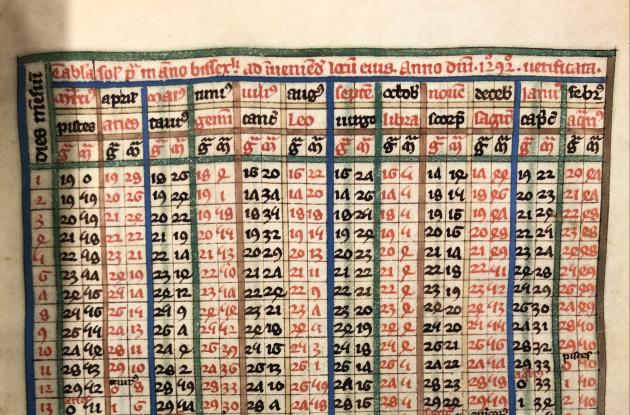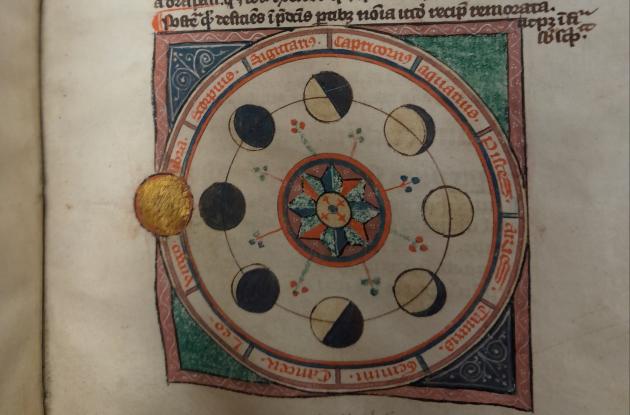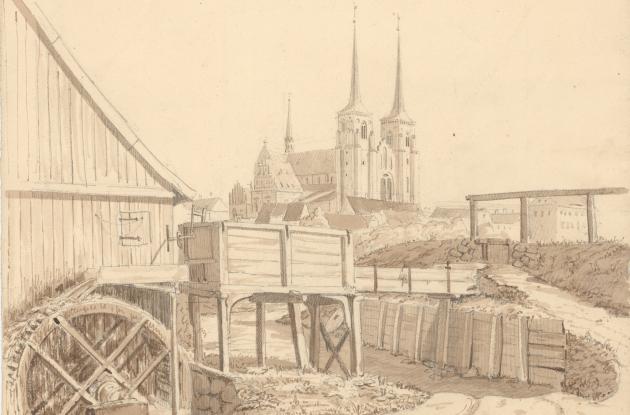The Nightingale from Roskilde
How are astronomy and Easter related? And who was the astronomer "Peter Philomena from Denmark"?
The Christian Easter falls on the first Sunday after the first full moon after March 21 - this has been the case since the church meeting in Nicaea 1700 years ago. In order to be able to celebrate the holidays at the right time, you depend on skilled astronomers who can calculate the movements of the moon and the course of the year.
In the medieval manuscript NKS 275 a quarter, which is in Royal Danish Library's collections, you can see how important it was to keep track of the movements of the celestial bodies in the Middle Ages. The manuscript is quite unique for several reasons: not only is it beautiful, with its decorated letters and gilded illustrations, but it contains a large collection of astronomical and mathematical texts.

Photo: Det Kgl. Bibliotek
From Paris to Roskilde
The manuscript is rare in a European context. Additions of Danish saints' festivals in the manuscript's calendar show that manuscripts were in use in Denmark, most likely in Roskilde. One of the additions is the celebration of Lucius, who was Roskilde's patron saint.
The manuscript was created in Paris at the end of the 13th century, and the additions of Danish saints' festivals can be dated to the same period. A mathematician and astronomer from Roskilde has thus had access to the manuscript. Perhaps the person himself acquired the book in Paris?

Photo: Det Kgl. Bibliotek
Astronomy of the Middle Ages
The study of the starry sky and the course of the sun was therefore important in the Middle Ages, and central to being able to calculate the time and thus celebrate Easter and Pentecost at the right times. Therefore, astronomy was among the seven free arts, the artes liberales, which formed the basis of all academic education - also in Denmark. A number of Danish students therefore applied to the new European universities. It could, for example, be the one in Bologna or the one in Paris, both of which arose in the 12th and 13th centuries. Perhaps we should find the book buyer among the Danish students in Paris.
The mysterious Peter Philomena
A Dane who has clearly received a solid education is referred to in various sources as Petrus Philomena de Dacia - Peter "Nightingale" from Denmark. How he got this name is not known, but maybe it was because he spent the nights awake studying the night sky? Peter left several advanced astronomical and mathematical works, including a commentary on the widespread textbook Algorismus vulgaris by Johannes Sacrobosco, as well as an astronomical calendar for a period of 76 years, beginning in 1292. This calendar contains a coordinate that was based on observations made throughout the year 1274 – in Roskilde.
Sources
- Petrus Philomena de Dacia (Danish biographical encyclopedia)
- Pedersen, O. 1976. "Petrus Philomena de Dacia: A problem of identity. With a survey of the manuscripts" Cahiers de l'Institut du Moyen-Âge grec et latin 19, 1-54
- The manuscript in our collection
The scholars in Roskilde
We know very little about Peter "Nightingale". He is mentioned in letters as canonicus Roskildensis, canon in Roskilde, in 1304, but other letters show that he was in Bologna around the year 1290. Perhaps he also received his education there, or in Paris. In any case, Peter is a good bet for the Dane who acquired the beautiful French manuscript NKS 275 a quarter. The manuscript contains works which must have been used by Peter, not least Algorismus vulgaris, for which he wrote a commentary.
Was it Peter who himself, as a young astronomer, made the observations in Roskilde in 1274? We do not know. Perhaps there was an environment connected to the cathedral where several people had scientific interests. Such an environment may have provided the academic foundation Peter needed to later pursue a career in Bologna. Regardless of whether it was Peter who brought the manuscript to Denmark, the manuscript gives us a unique glimpse of the advanced knowledge that existed in the High Middle Ages, also in Roskilde.
